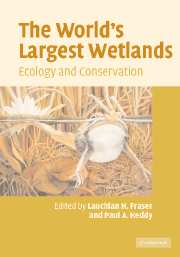Book contents
- Frontmatter
- Contents
- List of contributors
- Preface
- 1 Introduction: big is beautiful
- 2 The West Siberian Lowland
- 3 The Amazon River basin
- 4 The Hudson Bay Lowland
- 5 The Congo River basin
- 6 The Mackenzie River basin
- 7 The Pantanal
- 8 The Mississippi River alluvial plain
- 9 The Lake Chad basin
- 10 The River Nile basin
- 11 The prairie potholes of North America
- 12 The Magellanic moorland
- 13 The future of large wetlands: a global perspective
- Index
- References
6 - The Mackenzie River basin
Published online by Cambridge University Press: 10 August 2009
- Frontmatter
- Contents
- List of contributors
- Preface
- 1 Introduction: big is beautiful
- 2 The West Siberian Lowland
- 3 The Amazon River basin
- 4 The Hudson Bay Lowland
- 5 The Congo River basin
- 6 The Mackenzie River basin
- 7 The Pantanal
- 8 The Mississippi River alluvial plain
- 9 The Lake Chad basin
- 10 The River Nile basin
- 11 The prairie potholes of North America
- 12 The Magellanic moorland
- 13 The future of large wetlands: a global perspective
- Index
- References
Summary
Introduction
In Canada, wetlands are defined as “… land that is saturated with water long enough to promote wetland or aquatic processes as indicated by poorly drained soils, hydrophytic vegetation, and various kinds of biological activity which are adapted to a wet environment.” (National Wetlands Working Group 1988). The environmental processes that control wetland development form hydrological, chemical, and biotic gradients and commonly have strong cross-correlations. These interrelated gradients have been divided into five nodes that define Canada's wetland classes, of which three classes are non-peat-forming wetlands generally having <40 cm of accumulated organics and two classes are peatlands with >40 cm of accumulated organics. Non-peat-forming wetlands are subdivided into: (1) shallow open waters, (2) marshes, or (3) swamps; whereas peatlands can be subdivided into: (1) fens or (2) bogs (Fig. 6.1).
Non-peat-forming wetlands have a poorly developed bryophyte layer, which results from strong seasonal water-level fluctuations and high vascular plant production (Campbell et al. 2000). Peat accumulation is limited however, as decomposition rates are high. This situation is in contrast to the swamps and marshes found in more-temperate regions of the globe where peat accumulation can occur.
Peatlands differ from non-peat-forming wetlands by a combination of interrelated hydrological, chemical, and biotic factors that results in a decrease in decomposition relative to plant production and therefore allows for the accumulation of peat. The stabilization of seasonal water levels and restriction of water flow through a wetland allows the establishment and development of a bryophyte layer.
- Type
- Chapter
- Information
- The World's Largest WetlandsEcology and Conservation, pp. 166 - 202Publisher: Cambridge University PressPrint publication year: 2005
References
- 3
- Cited by



